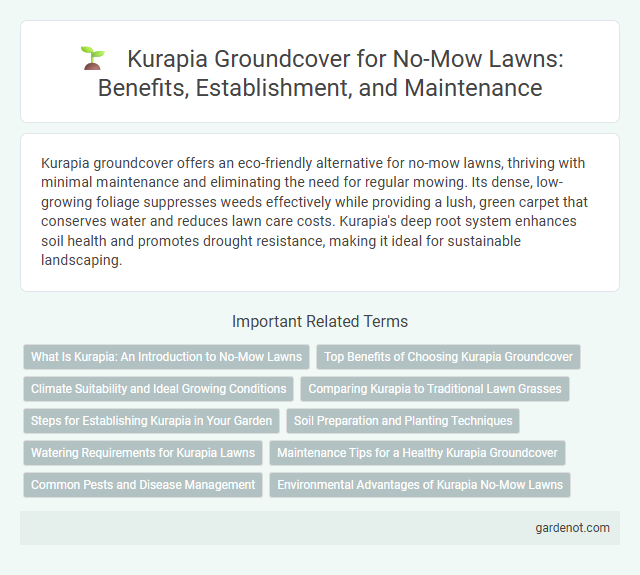Kurapia groundcover offers an eco-friendly alternative for no-mow lawns, thriving with minimal maintenance and eliminating the need for regular mowing. Its dense, low-growing foliage suppresses weeds effectively while providing a lush, green carpet that conserves water and reduces lawn care costs. Kurapia's deep root system enhances soil health and promotes drought resistance, making it ideal for sustainable landscaping.
What Is Kurapia: An Introduction to No-Mow Lawns
Kurapia is a drought-tolerant, low-maintenance groundcover ideal for no-mow lawns, growing up to 4 inches tall with dense, green foliage and small white flowers. It thrives in full sun to partial shade and requires minimal watering once established, making it an eco-friendly alternative to traditional grass. Kurapia's deep root system helps prevent soil erosion and supports pollinators, promoting a sustainable and attractive landscape.
Top Benefits of Choosing Kurapia Groundcover
Kurapia groundcover significantly reduces lawn maintenance by eliminating the need for mowing, watering, and fertilizing. Its deep root system enhances soil stability and drought resistance, making it an eco-friendly choice for sustainable landscaping. Kurapia's dense, low-growing foliage suppresses weeds and promotes a lush, green lawn with minimal environmental impact.
Climate Suitability and Ideal Growing Conditions
Kurapia groundcover thrives in USDA zones 5 through 10, adapting well to both hot and temperate climates with moderate humidity. It prefers well-drained soils and full sun exposure for optimal growth, though it can tolerate partial shade. This drought-resistant plant benefits from consistent moisture during establishment but requires minimal watering once mature, making it ideal for no-mow lawn solutions in diverse climate conditions.
Comparing Kurapia to Traditional Lawn Grasses
Kurapia offers drought tolerance and requires up to 70% less water than traditional lawn grasses, making it an eco-friendly alternative. Its deep-rooted system enhances soil stability and reduces erosion, unlike shallow-rooted turf. Kurapia also minimizes mowing needs, cutting maintenance time and carbon emissions compared to conventional lawns.
Steps for Establishing Kurapia in Your Garden
Preparing the soil by loosening it and removing weeds creates an ideal environment for Kurapia groundcover establishment. Regular watering during the initial growth period ensures deep root development and promotes dense coverage. Applying a light layer of mulch can help retain moisture and protect young Kurapia plants from extreme temperature fluctuations.
Soil Preparation and Planting Techniques
Kurapia groundcover thrives in well-drained, sandy to loamy soils with a pH between 5.5 and 7.5, requiring thorough soil preparation that includes removing existing grass and weeds, loosening the top 6 to 8 inches of soil, and incorporating organic matter to enhance fertility and drainage. Planting techniques emphasize using nursery-grown plugs or root cuttings spaced 6 to 12 inches apart to establish a dense, low-maintenance cover, with irrigation applied consistently during the initial establishment phase. Proper soil preparation and precise planting methods promote rapid Kurapia propagation, resulting in a durable, no-mow lawn alternative that suppresses weeds and reduces water use.
Watering Requirements for Kurapia Lawns
Kurapia lawns require minimal watering, thriving in drought-prone areas with as little as 1 inch of water per week once established. Deep, infrequent watering encourages strong root development and reduces water consumption compared to traditional grass. This groundcover's high tolerance to dry conditions makes it ideal for sustainable, no-mow lawn solutions in low-water landscapes.
Maintenance Tips for a Healthy Kurapia Groundcover
Kurapia groundcover thrives with minimal maintenance, requiring only occasional watering during dry periods to maintain its vibrant green appearance. Regular mowing is unnecessary as Kurapia naturally forms a dense mat, but light trimming can promote even growth and prevent seed formation. Applying a balanced, slow-release fertilizer in early spring supports robust root development and enhances overall plant health.
Common Pests and Disease Management
Kurapia groundcover exhibits strong resistance to common lawn pests such as armyworms, aphids, and white grubs, significantly reducing the need for chemical pesticides. Its dense growth habit minimizes weed invasion, limiting fungal diseases like powdery mildew and rust. Proper irrigation and soil drainage further enhance Kurapia's natural defense against root rot and other soil-borne diseases, promoting a healthy no-mow lawn environment.
Environmental Advantages of Kurapia No-Mow Lawns
Kurapia groundcover significantly reduces water consumption by thriving with minimal irrigation compared to traditional grass lawns, making it an eco-friendly choice for sustainable landscaping. Its dense growth pattern suppresses weeds naturally, eliminating the need for chemical herbicides that can harm local ecosystems. By requiring no mowing, Kurapia also lowers carbon emissions associated with lawn maintenance equipment, further enhancing its environmental benefits.
Kurapia groundcover Infographic

 gardenot.com
gardenot.com